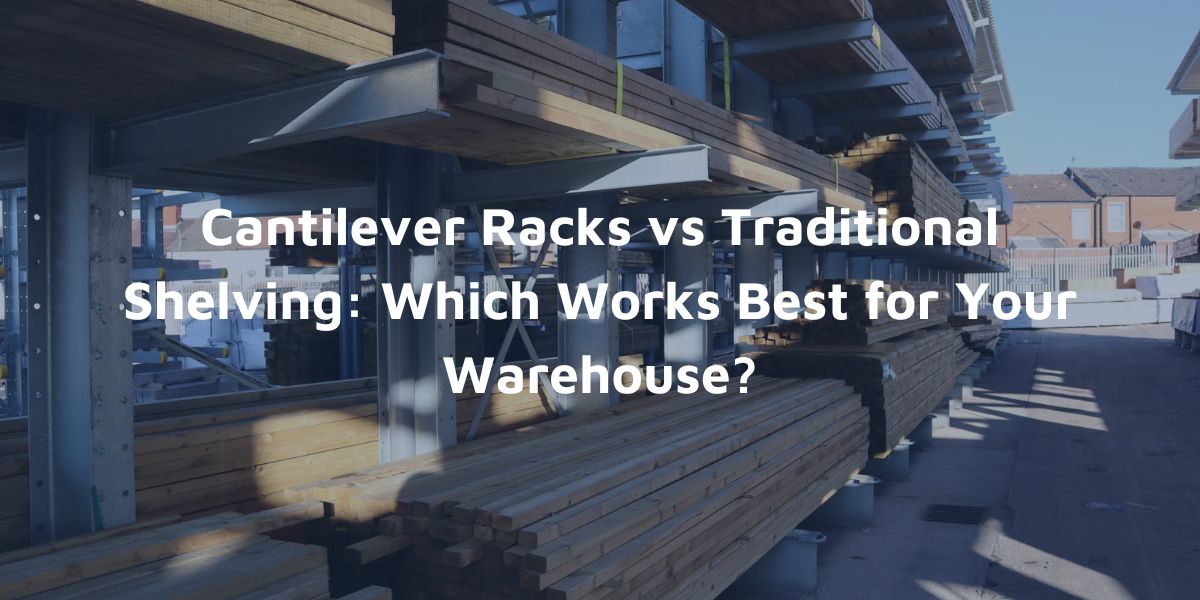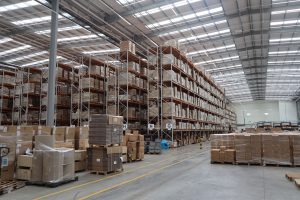When it comes to designing the perfect storage system for your warehouse, the choice between cantilever racks and traditional shelving is no small matter. Both options have their merits, but understanding their strengths and limitations can make all the difference in optimising your space and improving workflow efficiency.
In this blog, we’ll break down the pros and cons of each system, highlight situations where cantilever racks truly shine, and help you determine the best choice for your unique needs. Let’s dive in!
What Are Cantilever Racks?
Cantilever racks are a specialised type of warehouse racking system designed for storing long, bulky, or irregularly shaped items. Picture steel beams anchored to a vertical frame, with no front columns to obstruct access. These racks are ideal for holding products like:
- Lumber and timber
- Metal pipes and tubing
- Sheet materials (e.g., plasterboard, plywood)
- Long furniture pieces or awkwardly shaped items
Their open-front design makes loading and unloading a breeze, especially with forklifts. Plus, their structure is highly customisable, allowing for adjustable arms to accommodate different item lengths.
What Is Traditional Shelving?
Traditional shelving, on the other hand, refers to a more conventional storage system where shelves are supported by vertical uprights on all four corners. It’s the standard go-to for many warehouses handling smaller, uniform goods such as:
- Boxes or cartons
- Small tools or parts
- Products in consistent sizes and weights
This type of shelving comes in various forms, such as steel shelving, wire racks, or even pallet racks. It’s versatile, widely used, and offers excellent storage for non-specialised goods.
Key Comparison: Cantilever Racks vs Traditional Shelving
1. Storage Flexibility
- Cantilever Racks: Designed to handle long and oversized goods that traditional shelving simply can’t accommodate. With adjustable arms and no vertical obstructions, these racks are perfect for irregularly shaped items.
- Traditional Shelving: Best suited for standardised items. It lacks the flexibility needed for awkwardly shaped goods but excels at keeping smaller inventory neatly organised.
2. Ease of Access
- Cantilever Racks: The open-front design ensures quick and seamless access, especially for forklifts. No front posts mean fewer obstacles during loading or unloading, saving time and effort.
- Traditional Shelving: Items stored on deeper shelves can be harder to access, particularly if they’re stacked behind other items. This could slow down operations if frequent retrieval is required.
3. Weight Capacity
- Cantilever Racks: These racks are heavy-duty by design, capable of supporting immense weight loads over longer spans. Ideal for robust materials like steel beams or timber.
- Traditional Shelving: While also strong, the weight capacity is distributed across multiple shelves, which may not hold very large or heavy items effectively.
4. Customisation Options
- Cantilever Racks: Highly adaptable, with arms that can be adjusted to different lengths and heights. You can even add extra arms for greater storage.
- Traditional Shelving: Generally less customisable. Shelf heights can sometimes be adjusted, but the overall design is less accommodating for irregular items.
5. Space Optimisation
- Cantilever Racks: Great for vertical storage, freeing up floor space. They let you make the most of your warehouse height, especially if your facility has high ceilings.
- Traditional Shelving: Efficient for standardised items, but may not maximise space as effectively when dealing with oversized goods.
When to Choose Cantilever Warehouse Racks
Cantilever warehouse racks are a no-brainer in the following scenarios:
- Storing long or heavy items: If your warehouse regularly handles timber, pipes, or other lengthy materials, cantilever racks are your best bet.
- Maximising vertical space: With their ability to store items at various heights, cantilever racks help you make better use of warehouse real estate.
- Improving forklift efficiency: The open design is forklift-friendly, speeding up operations and reducing damage to products.
- Adapting to irregular inventory: If your storage needs often change, the customisable nature of cantilever racks can keep up with the demand.
When Traditional Shelving Is the Better Fit
Traditional shelving systems work well in situations where:
- You need organised storage for smaller goods: Ideal for items that fit neatly on shelves, such as boxes or parts.
- Budget is a priority: Traditional shelving is often more cost-effective than cantilever systems for standardised storage.
- Space isn’t an issue: If your warehouse layout allows for more floor space, traditional shelving can offer sufficient storage without over-complicating things.
Making the Right Choice for Your Warehouse
Ultimately, the decision between cantilever racks and traditional shelving boils down to the nature of your inventory and your operational needs. Here’s a quick summary to help you decide:
Factor | Cantilever Racks | Traditional Shelving |
Best For | Long, bulky, irregular items | Small, uniform goods |
Ease of Access | Excellent | Moderate |
Customisation | High | Low |
Weight Capacity | Very high | Moderate |
Space Optimisation | High (vertical storage) | Moderate |
Why Choose Total Interiors Direct for Your Storage Needs?
At Total Interiors Direct, we specialise in providing premium-quality cantilever warehouse racks designed to meet the unique demands of your business. With durable materials, versatile designs, and expert advice, we’re here to help you create a storage solution that boosts efficiency and productivity.
Whether you’re storing pipes, timber, or irregularly shaped materials, our cantilever racks are built to handle it all. Ready to upgrade your warehouse? Contact us today for a free consultation or browse our range of cantilever racks to find the perfect fit!
FAQs
1. Can cantilever racks handle heavy items?
Absolutely! Cantilever racks are designed to hold heavy, bulky items such as steel beams or timber.
2. Are cantilever racks expensive?
While they may have a higher upfront cost than traditional shelving, their durability and efficiency make them a worthwhile investment.
3. Can I combine cantilever racks with other storage systems?
Yes, many warehouses use a combination of cantilever racks and traditional shelving to maximise storage efficiency for different types of goods.
4. What materials are cantilever racks made of?
Typically, cantilever racks are made from high-strength steel to ensure they can support heavy loads safely.
Final Thoughts
Choosing between cantilever racks and traditional shelving doesn’t have to be overwhelming. By understanding your inventory and operational needs, you can make an informed decision that sets your warehouse up for success.
Need expert guidance? Let Total Interiors Direct help you transform your storage system today!























